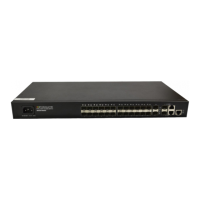Ethernet Port Configuration
Chapter 4. Ethernet Port
Configuration
This chapter describes the types of interfaces on switches and how to configure them.
4.1 Ethernet Port Overview
4.1.1 Link Type of Ethernet Ports
An Ethernet port can operate in one of the three link types:
Access: An access port only belongs to one VLAN, normally used to connect user device.
Trunk: A trunk port can belong to more than one VLAN. It can receive/send packets from/to
multiple VLANs and is generally used to connect another switch. The packet sent from this
port can only be with tag label.
Hybrid: A hybrid port can belong to multiple VLANs, can receive, or send packets for
multiple VLANs, used to connect either user or network devices. It allows packets of multiple
VLANs to be sent with or without the tag label
4.1.2 Configuring Default VLAN ID for Ethernet Port
Both hybrid port and trunk port can belong to more than one VLAN, but there is a default
VLAN for each port. The default VLAN ID (PVID) is VLAN 1 and it can be changed if
necessary (the way to change PVID refers to Table 4-5)
4.1.3 Handling packets
Different ports have different ways to handle the packet. Details are in Table 4-1.
Table 4-1 Different port handles different packet
Receive it and
add a tag with
VID being
equal to PVID.
If VID of the
packet is equal
to the port
permitted VID,
receive it; if VID
is different,
discard it.
Strip the Tag and transmit the packet as the VID
of the packet is equal to the port permitted VID
If VID of the packet is equal to the port permitted
untag VID, remove the tag and transmit it; If VID
of the packet is equal to the port permitted tag
VID, keep the tag and transmit it.
If VID of the packet is equal to the port permitted
VID, keep the tag and transmit it.

